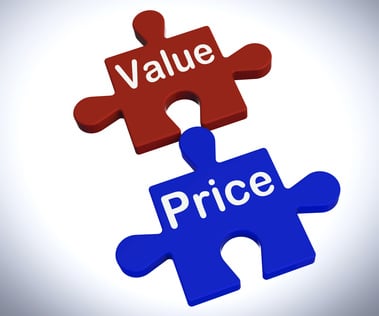This guest post is authored by Paul Dunn, vice president of sales at MAVERICK Technologies.
For many people in the controls systems industry the word that seems to get thrown around a lot is value. What is value? It is defined differently to the various stakeholders in any project (engineering, maintenance, project manager, management, purchasing, EH&S and the vendor), which often leads to misalignment of the desired outcome vs. actual  delivery.
delivery.
Value is first defined in the Merriam Webster online dictionary as, “the amount of money that something is worth; the price or cost of something.” This definition essential creates the equation Value = Price. From personal and professional observation, this seems to be the definition that most customers utilize when making a buying decision with regard to technology. The assumption is made that all of the requisite bidders have the same quality, hardware, software, engineering capability, process knowledge, personnel availability and financial standing. An RFQ is provided to the three or four vendors that meet very limited “pre-qualifications” and then the project is turned over to the vendor who provided the lowest price. It is often assumed that the RFQ contains sufficient scope to enable any company to perform it.
Alas, many end-user companies are stretched very thin, and the development of these documents is often reduced to a “do it minimally” mentality. From a sales perspective, we often call the “winner” of these RFQs the company that overlooked the most scope. This process can and does work, but that tends to be a result of the skill of the individual contributors working for both the client and the vendor to achieve the goals. In many more cases, these projects do not deliver the results that they were intended to. There is a great difference between value and price. The bitter taste of poor quality and lost production (i.e. lack of value) linger far longer than the sweet taste of low price. A better “value” is needed to achieve more consistent success.
There are several other definitions of value in the same dictionary that are better applicable to the automation world. They include, “a fair return or equivalent in goods, services, or money for something exchanged” and “usefulness or importance.” Keying on that last phrase, here are the typical items of importance that the stakeholders above tend to hold dear (there are many others):
- Engineering – Most effective technology
- Maintenance – Longest lasting, most hands off, easiest to fix
- Project Management – Scope, schedule and budget all met
- Management – Low downtime, higher efficiency
- Purchasing – Lowest price
- EH&S – No one gets hurt
- Vendor – Scope, schedule and budget all met
In order for everyone to get the value they are looking for, a great deal of thought needs to be put into the actual needs from each department. When this is done with specific intent at the outset of an initiative, great results tend to follow. Too often, we see customers rush to attempt a project that is meant to improve the overall production of a facility, which results in the complete opposite effect. This is primarily due to the lack of input and planning from all of the stakeholders, failing to identify what is strategically important. An hour of upfront planning leads to many hours saved on the back end of a project (yet this seems to be the most ignored advice by leadership in many companies).
The next time your company is involved in a technology upgrade, take the time to clearly understand the needs of each segment of your business. What are your business strategies and how does the project help you to achieve them? If you spend more, what is the benefit to doing so? Is it short term or long term? The companies that choose to evaluate value from the second definition are the ones that are more likely to not only keep their standing in the marketplace, but expand it. Those that choose the first definition tend to become targets of acquisition or closure. The winning companies are the ones that take the opportunity to investigate the up-front project costs AND the long term financial benefits of their proposed technological moves. The investigative cost may be higher, but the maximized benefit will be greater.
On your next project, make the choice to invest time into studying the problem from a broader perspective, gaining consensus from the team around you, clearly defining what value is. The companies that have the courage to investigate and innovate instead of replicating the exact systems that they currently own will be the ones that are here for the long term. Each company needs to make a choice. Will you lead and thrive, or will you follow and fade away?
About the Author Paul Dunn is responsible for attracting, training and retaining a team of business development professionals who provide solutions within the manufacturing technology industry. In his position, he develops marketing strategies, manages the internal sales budget and develops mutually beneficial key partnerships with technology providers. Paul has been with MAVERICK since 2009, when he joined the company as a business development manager. Paul has more than 20 years of experience in automation engineering and business development.
Paul Dunn is responsible for attracting, training and retaining a team of business development professionals who provide solutions within the manufacturing technology industry. In his position, he develops marketing strategies, manages the internal sales budget and develops mutually beneficial key partnerships with technology providers. Paul has been with MAVERICK since 2009, when he joined the company as a business development manager. Paul has more than 20 years of experience in automation engineering and business development.
Connect with Paul:![]()
![]()



